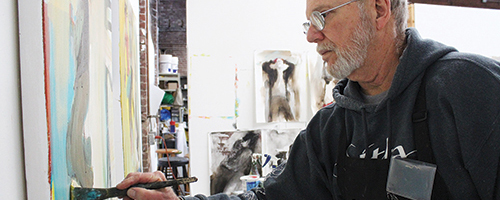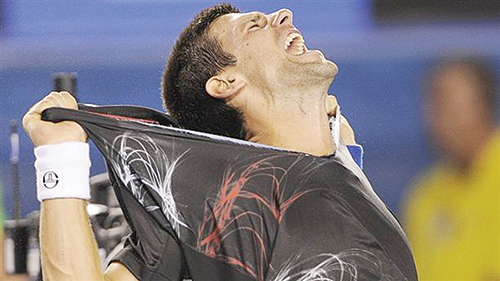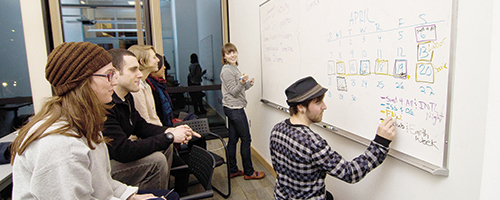The creation of art has always been used for more than just aesthetic appeal. For some people, art is a type of therapy. For others, art is a method for safely expressing themselves. And some create art to alleviate a physical ailment.
P:ear ‘jumps for joy’
[portfolio_slideshow id=45467]
The creation of art has always been used for more than just aesthetic appeal. For some people, art is a type of therapy. For others, art is a method for safely expressing themselves. And some create art to alleviate a physical ailment.
Local art nonprofit p:ear has found yet another use for the creation of art.
Next Thursday, p:ear will open its gallery doors to show local artists’ work, including that of well-known painter William Park. The show, titled “Jumping For Joy,” differs from most in that the featured artists are the displaced youth of Portland.
P:ear is an organization that “builds positive relationships with homeless and transitional youth through education, art and recreation to affirm personal worth and create more meaningful and healthier lives,” according to its website.
P:ear’s space in Northwest Portland features an art gallery in which displaced youth are able to display the artwork they create at the site. Local artists’ work is shown alongside that of the youth.
Most of the art supplies used by p:ear are donated by Utrecht, an art supply store. When artwork is sold, 90 percent of the proceeds go directly to the youth while the organization keeps 10 percent.
Park, who has worked with p:ear before, enjoys the experience of not only displaying his artwork but also giving workshops to any youth interested in furthering their artistic endeavors.
“It was gratifying and I learned an awful lot,” Park said of his past work with p:ear. “It was a good experience for me. I’m glad to be involved with p:ear; they are a wonderful group of people and they do terrific work.”
Park’s work for “Jumping For Joy” involves oil, acrylic and etching ink on canvas. The pieces showcase people jumping and the joy that loving life can bring. Park explains that a little bit of his own personality can be found in each piece.
“The one that’s on the card piece is called Vicarious Pleasure; it is part of the ‘Jumping For Joy’ series,” Park said. “Most of them will have a title that will have ‘jumping for joy’ with a number, and every now and then one will be called…something else.
“There’s a character that came out in that painting of Vicarious Pleasure that I may use. I’ve named her Elvira, and she seems to represent a part of me when I was a kid,” Park said. “She’s kind of goofy-looking and stands off to the side, kind of watches and wants to participate. She wears glasses like I do and did then.”
During his first few years of involvement, Park encountered the reason he became involved with the organization in the first place.
“Last time I was working with a few people, and Pippa [Arend, p:ear’s development director] was in there in the room with us, and after she left I just made mention to the young man across the table from me and said ‘Pippa’s pretty cool, huh?’ And without skipping a beat, he said, ‘Pippa saved my life,’” Park said. “I just got chills when I heard [that] and realized that that’s what they do.
“They save lives, they help lives and they do incredible work for young people who are lost and are having problem[s],” Park said. “Even if they don’t save their lives they give them the opportunities to make their lives better. That’s what I really like about working with p:ear.”
Arend explained that this type of reaction is what p:ear strives for: Through creating pieces at a set venue, the youth involved are able to gain an opportunity to experience a sense of belonging, some for the very first time.
“Jumping For Joy”: William Park and p:ear youth
Exhibit: Feb. 7–March 22
Opening reception: Thursday, Feb. 7, 6–9 p.m.
p:ear gallery
338 NW Sixth Ave.
Free and open to the public; donations accepted
“One of the main things that people get [out of p:ear] is they learn that they can be a part of their community in a way that it is looked up to; this gallery becomes a place that is their own,” Arend said. “These children are homeless and don’t have a place of their own, so when they show their work in a gallery they can invite people to their place.
“The gallery is one of the bridges these kids have with their community,” Arend said. “Instead of asking for change outside of Nordstrom, they get to showcase their art. It’s fundamentally a place of pride.”
In interviews conducted by p:ear staff, a few of the youth reactions to having this venue were powerful. One youth said, “Art affects my life by giving me a positive focus and a respite from the fear and anxiety I feel when I’m outside.”
Another said, “When I create, I remember who I really am, because it is an expression of my deepest identity.”
Arend invites everyone to the “Jumping For Joy” exhibit not only for aesthetics but also to support and help raise awareness for p:ear’s greater cause.
“I hope they get a taste for art out of this art show. I hope that they come to see these youth differently,” she said. “I hope they see [these] youth as normal…that they can be just kids.”





